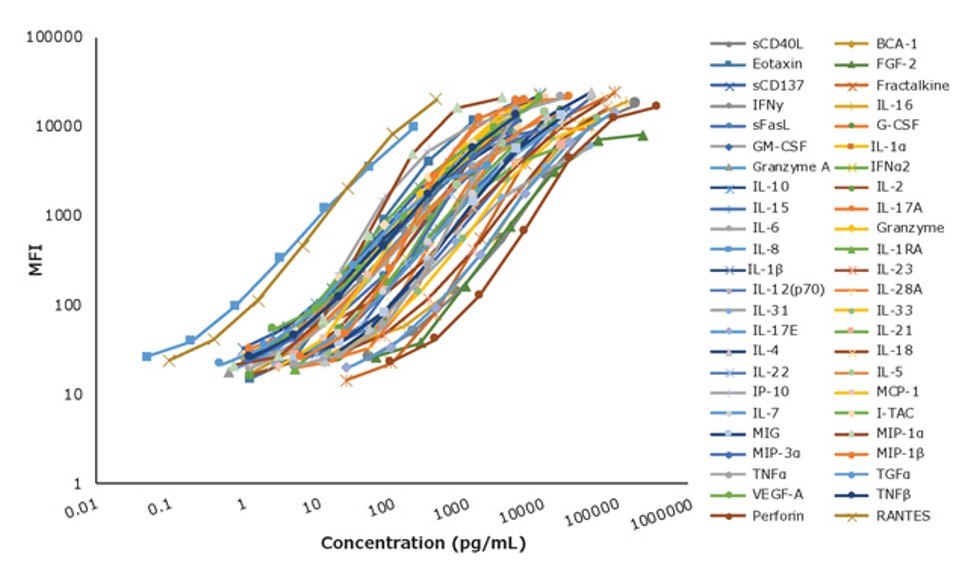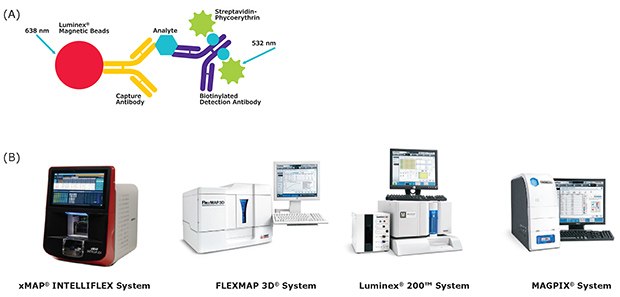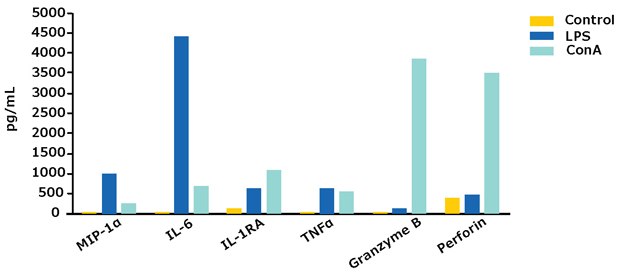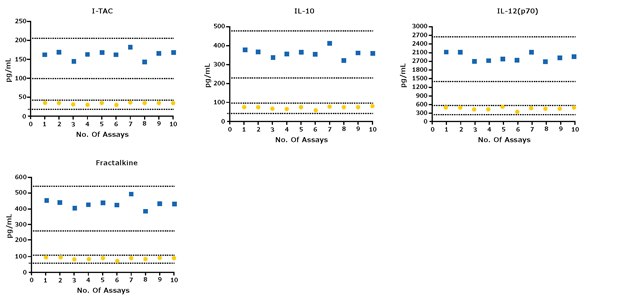MILLIPLEX® Non-Human Primate Cytokine/Chemokine/Growth Factor Panel A: The Largest Selection of Immune Factors Available for Non-Human Primates
Profile the largest selection of immune factors available for non-human primates on one 96-well plate with the MILLIPLEX® Non-Human Primate Cytokine/Chemokine/Growth Factor Panel A 48-Plex. Save time and sample volume, with the ability to generate more than 1,800 data points in a single plate when samples are analyzed in duplicate. This MILLIPLEX® kit was built with flexibility in mind, offering the option to select only the analytes needed to meet research needs. Additionally, a custom premix can be selected, and the panel is available as a fixed 38-plex or 48-plex premixed bead kit.
Section Overview

Figure 1.MILLIPLEX® Non-Human Primate Cytokine/Chemokine/Growth Factor Panel A Standard Curves. Standard curves for all analytes performed in MXPRSM-A serum matrix except RANTES that was in L-AB assay buffer. This assay was performed using the Cat. No. PRCYTA-40K overnight protocol.
What are Cytokines, Chemokines, and Growth Factors?
Cytokines are a diverse group of small proteins, peptides, or glycoproteins secreted by lymphocytes, monocytes, macrophages, and other cells that regulate immune responses, hematopoiesis, and lymphocyte development. Cytokines include:
- Interleukins
- Interferons
- Chemokines
- Other signaling molecules
Growth factors are extracellular polypeptides that have a positive effect on cell growth and proliferation. Growth factors and cytokines are similar in structure and the way of action. Each cytokine or growth factor acts through its own receptor on target cells to generate signaling pathways, and consequently to regulate biological processes. The expression of cytokines or growth factors and their receptors is highly regulated. Dysregulation may contribute to many diseases such as infectious disease, autoimmune and chronic inflammatory disease, cardiovascular disease, metabolic syndrome, neurological disorders, and cancer.
Cytokine and growth factor research help researchers gain a deeper understanding of the immune system and how to combat its related diseases. As the most closely related species to humans, non-human primates are critical models for these studies.
Importance of Non-Human Primates in Biomedical Research
Non-human primates play a critical role in biomedical research due to their genetic, physiological, and behavioral similarities to humans. Old World monkeys are extensively utilized in vaccine development, infectious disease research, neuroscience, pharmacology, toxicology, reproductive and developmental studies, as well as preclinical drug testing and behavioral research. Marmosets, known for their small size and rapid reproduction, are particularly valuable in neuroscience research and serve as transgenic models, facilitating the study of genetic diseases and the effects of therapeutic interventions.1 Squirrel monkeys are emerging as important models for Alzheimer’s disease research and malaria vaccine development, providing insights into disease mechanisms and potential treatments.2 Cytokines and chemokines play key roles in immune responses, inflammation, and cell signaling, making them essential in non-human primate research for understanding disease processes and evaluating therapeutic interventions.
MILLIPLEX® Assay Development
The MILLIPLEX® Non-Human Primate Cytokine/Chemokine/Growth Factor Panel A kit was developed using magnetic microsphere beads from Luminex® Corporation.3 Each set of beads is distinguished by different ratios of two internal dyes yielding a unique fluorescent signature for each bead set. Capture antibodies were coupled to the magnetic beads. Figure 2 shows the Luminex® methodology and instrumentation.

Figure 2.(A) Luminex® protein detection immunoassay method. (B) Instruments for use with MILLIPLEX® kits (xMAP® INTELLIFLEX®, FLEXMAP 3D®, Luminex® 200™, and MAGPIX® systems).
MILLIPLEX® Quality and Assay Verification
Kit development and verification begin with testing for selectivity and specificity to ensure negligible cross-reactivity in the tested sample types and to confirm the consistent performance of an assay in single-plex vs. multiplex formats. Buffers and diluents are optimized to enhance antibody specificity, such that only those analytes of interest are detected in samples. The serum matrix was carefully selected and optimized for use in the standard curve and Quality Control (QC) wells when using serum or plasma samples to mimic the sample matrix most closely, thus normalizing assay performance. The streptavidin-phycoerythrin (SAPE) concentration was titrated in-house for optimal signal and is provided ready-to-use with no dilution required. Additionally, all MILLIPLEX® kits are rigorously tested for shipping stability, and samples are also tested for temperature and freeze/thaw tolerance.
Sample dilution testing was also performed to ensure biologically relevant samples are detectable and fall on the linear portion of the standard curves. Using MILLIPLEX® Non-Human Primate Cytokine/Chemokine/Growth Factor Panel A, serum and plasma from six non-human primate species were tested. The assay was fully verified with two of the most studied non-human primates, rhesus macaques (Macaca mulatta) and cynomolgus macaques (Macaca fascicularis). Additional testing was performed using serum and plasma from baboon (Papio cynocephalus), African green monkeys (Cercopithecus aethiops), and plasma from squirrel monkeys (Saimiri sciureus) and common marmosets (Callithrix jacchus). Additionally, cynomolgus macaque peripheral blood mononuclear cells (PBMCs) were evaluated.
QCs, which are low and high dilutions of recombinant proteins for each analyte, are manufactured such that each QC has optimal placement on each standard curve. QC range sheets are provided with each kit. Additionally, it is recommended that users include experiment-specific samples for use as controls in each assay.
Immunoassay Workflow
The MILLIPLEX® Non-Human Primate Cytokine/Chemokine/Growth Factor Panel A includes a detailed, easy-to-follow protocol with a familiar workflow. Additionally, many of our kit components arrive ready-to-use, reducing assay variability and the amount of time spent preparing reagents. Detecting 48 immune markers at pg/mL levels with standard curve concentrations that remain the same from lot to lot affords a user-friendly experience. Consistent standard curves across lots allow for consistency in sample results across a project, and therefore reliable results.
Learn more about MILLIPLEX®multiplex panels in our Overview of Luminex® Multiplex Assay Technology page.
NHP Species Sample Detection
For most analytes, Old World monkey species exhibit better sample detectability compared to the two New World monkey species tested as shown in Table 1. This advantage is primarily due to the high genetic similarity between humans and Old World monkeys, which may be enhanced by human-specific antibodies and reagents. Additionally, there is a greater investment in developing species-specific reagents for Old World monkeys, while reagents for New World monkeys remain limited.
Despite these challenges, the MILLIPLEX® Non-Human Primate Cytokine kit successfully detects multiple analytes in squirrel monkey and marmosets, including sFasL, IL-2, IL-17A, IL-22, MIP-1β, TGFα, VEGF-A, and TNFβ. Squirrel monkeys tend to exhibit high homology for IL-2 with humans and Old World monkeys4; however, specific published sequence or functional homology data for the other cytokines in squirrel monkeys is currently limited. Figure 3 illustrates sample concentration by species for a subset of analytes.

Figure 3.Sample concentrations by species for select analytes in MILLIPLEX® Non-Human Primate Cytokine Panel A. Test samples included serum and plasma from rhesus (n=14), cynomolgus (n=17), baboon (n=9), African green (n=9) monkeys, and plasma from squirrel monkeys (n=5) and common marmosets (n=5).
Cynomolgus macaque PBMCs demonstrated increased concentrations in several analytes when stimulated with either Con A or LPS compared to the unstimulated control. Representative data is shown in Figure 4.

Figure 4.Average concentrations of six analytes in two cynomolgus macaque PBMC samples. PBMCs were tested as unstimulated control, stimulated with LPS, and stimulated with Con A.
Vendor Performance Comparison
MILLIPLEX® Non-Human Primate Cytokine Panel A was evaluated against several Luminex® brand kits, designated as Brand X, Y, and Z. The Brand X kit included 32 common analytes, which were processed as 2 separate kits to accommodate necessary sample dilutions. G-CSF, IL-8, and RANTES required a 1:10 dilution as recommended by the vendor. In the comparative analysis, 23 out of 32 analytes (72%) in the MILLIPLEX® kit exhibited comparable or superior sample detectability compared to Brand X. Similarly, for Brand Y, which included 24 common analytes, 19 out of 24 (79%) showed comparable or improved detectability in the MILLIPLEX® assay. Brand Z featured 29 overlapping analytes, with 25 out of 29 (86%) demonstrating equivalent or enhanced detectability in the MILLIPLEX® kit. Figure 5 illustrates the analyte concentrations in serum and plasma samples from rhesus, cynomolgus, baboon, and African green monkeys, including LPS-stimulated serum and plasma from both rhesus and cynomolgus monkeys at various time points. There are 13 unique analytes not found in the other vendor assays that were tested, including sCD137, Fractalkine, IL-16, sFasL, IL-1α, Granzyme A, IL-28A/IFNλ2, IL-31, IL-33, IL-17E, IL-22, TNFβ, and Perforin.

Figure 5.MILLIPLEX® Non-Human Primate Cytokine Panel A sample concentration comparison with other Luminex® brand multiplex kits. Representative data are shown for IL-1β, IL-2, IL-4, IL-5, and IL-6. Test samples included serum and plasma from rhesus (n=4), cynomolgus (n=4), baboon (n=4), African green (n=4) monkeys, and LPS-stimulated serum and plasma at various time points from rhesus and cynomolgus macaques (n=16).
Reproducibility
Consistent plate-to-plate performance is important when evaluating samples over time. To test reproducibility in the MILLIPLEX® Non-Human Primate Cytokine/Chemokine/Growth Factor Panel A, duplicate wells of our QC1 and QC2 were tested across ten 96-well plates during assay verification. Representative data from four analytes is illustrated in Figure 6.

Figure 6.QC1 (yellow) and QC2 (blue) were prepared according to the protocol and measured over 10 assays. All QCs read within the ±20% of each other and within the assigned QC ranges provided in the kit (dashed lines).
Summary
The MILLIPLEX® Non-Human Primate Cytokine/Chemokine/Growth Factor Panel A provides an extensive range of analytes in a flexible format, allowing users to configure a panel or select a fixed premix. With the inclusion of new analytes and an optimized protocol, the panel enhances workflow efficiency and reliability in biomarker analysis.
Comparative studies show that the MILLIPLEX® panel outperforms other Luminex® kits (Brands X, Y, and Z) in sample detectability. Additionally, it successfully detects several analytes in squirrel monkeys and marmosets, with 13 unique analytes not found in other vendor assays.
Related Products
For Research Use Only. Not For Use In Diagnostic Procedures.
References
To continue reading please sign in or create an account.
Don't Have An Account?